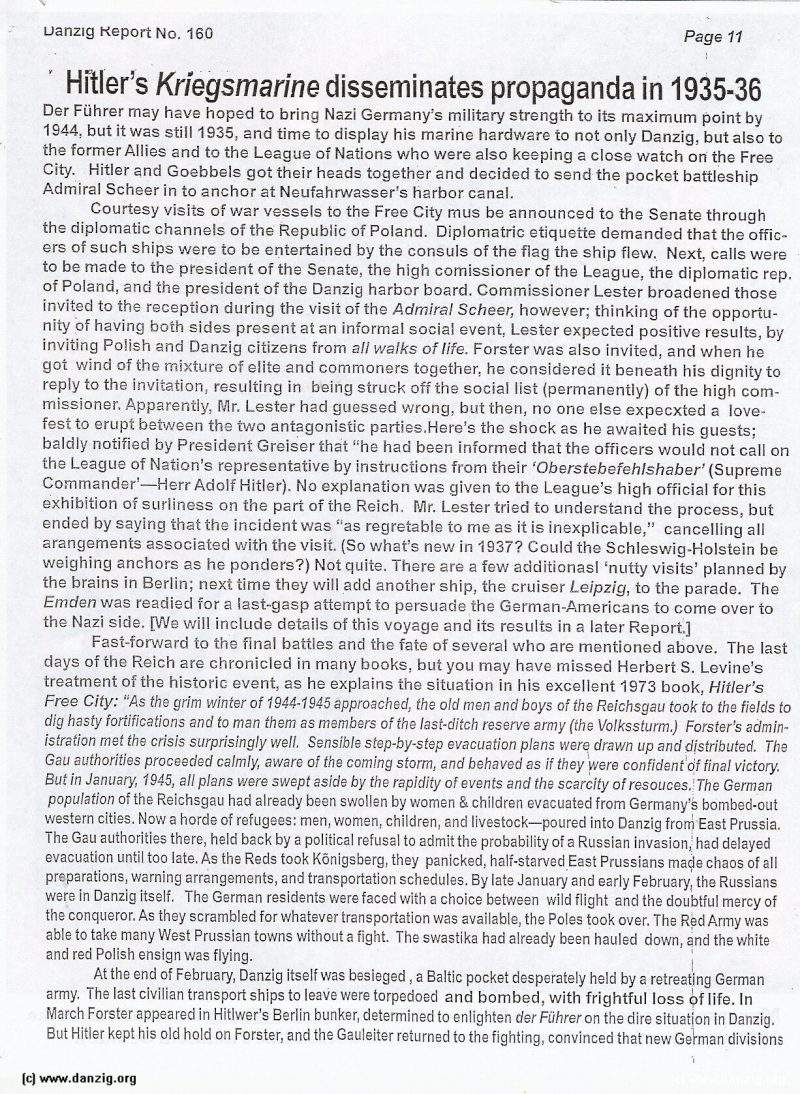
Hitler’s Kriegsmarine disseminates propaganda in 1935-36
Der Führer may have hoped to bring Nazi Germany’s military strength to its maximum point by 1944, but itwas still 1935, and time to display his marine hardv’iareto not only Danzig, but also to the former Allies and to the League of Nations who were also keeping a close watch on the Free City. Hitler and Goebbels got their heads together and decided to send the pocket battleship Admiral Scheer in to anchor at Neufahrwasser’s harbor canal.
Courtesy visits of war vessels to the Free City rnus be announced to the Senate through the diplomatic channels of the Republic of Poland. Diplomatric etiquette demanded that the office rs of such ships were to be entertained by the consuls of the flag the ship flew. Next, calls were to be made to the president of the Senate, the high comissioner of the League, the diplomatic rep. of Poland, and the president of the Danzig harbor board. Commissioner Lester broadened those invited to the reception during the visit of the Admiral Scheer, however; thinking of the opportun ity àf having both sides present at an informal social event, Lester expected positive results, by inviting Polish and Danzig citizens from all walks of life. Forster was also invited, and when he got wind of the mixture of elite and commoners together, he considered it beneath his dignity to reply to the invitation, resulting in being struck off the social list (permanently) of the high comm issioner. Apparently, Mr. Lester had guessed wrong, but then, no one else expecxted a lovef est to erupt between the two antagonistic parties.Here’s the shock as he awaited his guests; baldly notified by President Greiser that “he had been informed that the officers would not call on the League of Nation’s representative by instructions from their ‘Oberstebefehlsha her’ (Supreme Cornmancler’—Herr Adolf Hitler). No explanation was given to the League’s high official for this exhibition of surliness on the part of the Reich, Mr. Lester tried to understand the process, but ended by saying that the incident was “as regretable to me as it is inexplicable,” cancelling all arangements associated with the visit. (So what’s new in 1937? Could the Schleswig-Holstein be weighing anchors as he ponders?) Not quite. There are a few additionas! ‘nutty visits’ planned by the brains in Berlin; next time they will add another ship, the cruiser Leipzig, to the parade. The Emden was readied for a last-gasp attempt to persuade the German-Americans to come over to the Nazi side. [We will include details of this voyage and its results in a later Report.]
Fast-forward to the final battles and the fate of several who are mentioned above. The last days of the Reich are chronicled in many books, but you may have missed Herbert S. Levine’s treatment of the historic event, as he explains the situation in his excellent 1973 book, Hitler’s Free City: ‘As the grim winter of 1944-1945 approached, the old men and boys of the Re!chsgau took to the fields to dig hasty fortifications and to man them as members of the last-ditch reserve army (the Volkssturm.) Forsters admini stration met the crisis surprisingly well, Sensible step-by-step evacuation plans were drawn up and distributed. The Gau authorities proceeded calmly, aware of the coming storm, and behaved as if they were con fidentdf final victory. But in January, 1945, all plans were swept aside by the rapidity of events and the scarcity of resouces. The German population of the Reichsgau had already been swollen by women & children evacuated from Germany’s bombed-out western cities. Now a horde of refugees: men, women, children, and livestock—poured into Danzig fron East Prussia. The Gau authorities there, held back by a political refusal to admit the probability of a Russian invasion, had delayed evacuation until too late. As the Reds took Königsberg, they panicked, half-starved East Prussians maçle chaos of all preparations, warning arrangements, and transportation schedules. By late January and early February the Russians were in Danzig itself. The German residents were faced with a choice between wild flight and the doubtful mercy of the conqueror. As they scrambled for whatever transportation was available, the Poles took over. The Red Army was able to take many West Prussian towns without a fight. The swastika had already been hauled down, and the white and red Polish ensign was flying.
At the end of February, Danzig itself was besieged , a Baltic pocket desperately held by a retreatlng German army. The last civilian transport ships to leave were torpedoed and bombed, with frightful loss bf life. In March Forster appeared in Hitiwer’s Berlin bunker, determined to enlighten der Führer on the dire situation in Danzig. But Hitler kept his old hold on Forster, and the Gauleiter returned to the fighting, convinced that new German divisions
Danzig Report Nr. 159 - 1st Quarter 2013, Page 11.
Hits: 3382
Added: 12/08/2015
Copyright: 2025 Danzig.org

